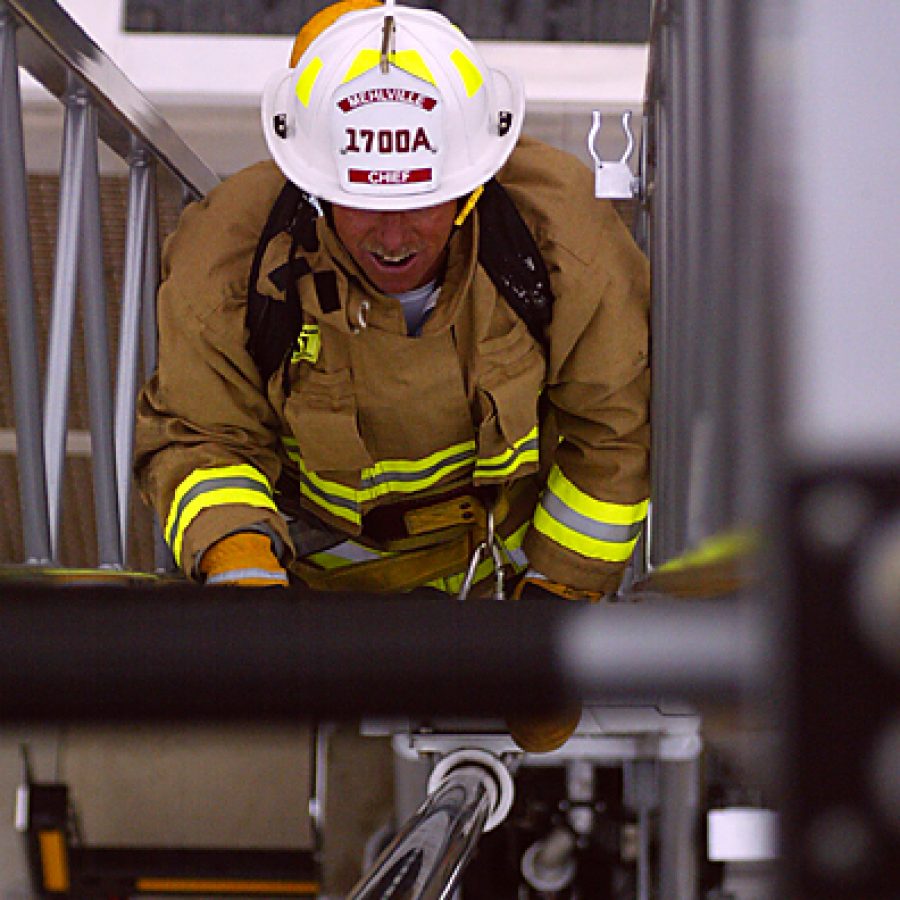A revised fit-for-duty policy and new wellness program policy were adopted last week by the Mehlville Fire Protection District Board of Directors.
Board Chairman Aaron Hilmer and board Secretary Ed Ryan voted Nov. 3 to adopt the policies. Board Treasurer Bonnie Stegman was absent.
Administrative Chief Fire Officer Tim White informed board members in September of his desire to improve the overall health of employees and proposed a “three-prong approach” that included the revised fit-for-duty policy, a new wellness program and physical-fitness program.
The Board of Directors established a mandatory fit-for-duty policy in August 2006. Under the policy, all 24-hour personnel with the rank of captain or below are required to have an annual fitness-for-duty evaluation. Such evaluations determine whether an employee is:
Fit to work without limitations.
Fit to work with identified limitations.
Not fit for duty.
In September, White told board members he believed the fit-for-duty policy needed to be revised to better reflect the conditions in which district employees work.
Of the revised policy, White told the Call, “I think this accurately reflects what the demands are of the job. Though we’ve had a fit-for-duty test, it didn’t accurately reflect what the demands are on the firefighters and the fire-medics here as well as the paramedics to meet the challenges of the job. It’s very physical. It’s very demanding, and this actually replicates what they will be faced with.
“It’s to everybody’s best interest that there’s a level of proficiency and namely the taxpayers, for them to know that yes, the employees can do it. It’s been proven. It’s documented. It’s shown that they can meet the demands that the public puts on them under very strenuous conditions.”
Hilmer told the Call he’s pleased with the revised fit-for-duty policy.
“It was a long time coming. I thought that Chief Tim White did an excellent job of putting it together,” he said. “It’s not only for the safety of the residents, it’s also for the safety of employees and more importantly their fellow employees to know that everyone can perform the job that they’re getting paid well to do.”
The revised policy was effective immediately and 12 employees last week took the fit-for-duty evaluation.
“… So far 12 people have taken the test. All 12 have passed,” Hilmer said. “That’s roughly 10 percent of our workforce. So the other 90 percent will be taking it in the near future.”
The revised fit-for-duty policy was formulated with the assistance of PRORehab and includes a variety of drills.
Timed components of the fit-for-duty evaluation for firefighters and fire-medics include such tests as:
Climbing up and down a stairwell three times with 100 feet of 1.75-inch hose in full turnout gear and an air pack, and then walking 100 feet.
Dragging 200 feet of 1.75-inch hose 75 feet, making a 90-degree turn, going another 25 feet, then stopping and pulling 50 feet of hose to you. Walking 100 feet.
Untimed components of the fit-for-duty evaluation for firefighters and fire-medics include such tests as:
Climbing a 100-foot aerial ladder and coming back down.
Hoisting a 1.75-inch hose line 30 feet.
Paramedics will have to complete a fit-for-duty test that is “not as strenuous” as the one firefighters and fire-medics must complete, according to White.
The new wellness program policy stipulates that employees who participate in the district’s health-insurance plan will participate in the wellness program. An employee’s spouse also will be eligible to participate in the wellness program if he or she is covered under the district’s health-insurance plan.
Under the program, employees will be screened annually for a myriad of conditions, including ones that are controllable by the employee such as blood pressure, cholesterol, glucose, triglycerides and tobacco use.
“For the first time, what we’re doing is, is reaching out, not only giving the employee the ability to identify possible physiological problems that they may be experiencing, whether it be liver issues, cholesterol issues, smoking cessation, whatever the situation is …,” White said. “Not only does it target those areas, but it’s all HIPAA (Health Insurance Portability and Account-ability Act) compliant and the employer, i.e. us, will not have any idea what they’re experiencing. That way, they can actually … make a lifestyle change.
“This will then not only enhance their performance here at the job, but will carry them on all the way through their career and into their retirement. So what we’re doing is meeting the needs of the employees to the highest degree.”
White said he still is in the process of formulating the physical-fitness program.
“… There are several parameters that are being looked at,” he said. “A lot of it is geared to what is exactly going to be the performance at the fit-for-duty test. So once that data is collected, then the formulation can then move forward — and there again, meeting the needs of the employees, which ultimately meets the needs of the taxpayers to make sure that they are fit and ready to meet the needs of the taxpayers under very strenuous conditions. The last thing we want is to identify a problem area actually while we’re in the midst of helping someone …”




















